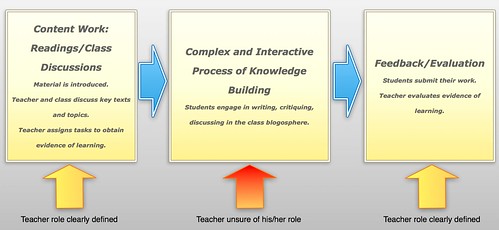Thoughts on Assessment
My presentation at EduCon 2.1 helped me conceptualize some of my thoughts and research efforts on assessment in the 21st-century classroom. My interest in assessment emerged out of my research on blogging communities and adolescent literacy. The student participants in my study engaged in writing and reading through a variety of complex and rich interactions. They posted their own work on their blogs, commented on the work of their peers, linked to each other’s work, and initiated numerous conversations in the class blogosphere. My biggest challenge as a teacher-researcher was to figure out what kind of role I should play in the community. The traditional role of the teacher seemed inadequate. I knew that, as active bloggers and communicators, the students would not respond well to a teacher who enters the class blogosphere only to assign work or to evaluate their writing. Then another issue arose quite quickly - assessment. Once I started responding to student work in a readerly fashion and participating as a contributor, reader, and not just an evaluator, I realized that it would be unfair to the students to reduce all their rich interactions and complex online presence to a B+ or a 13/15. I realized that I needed to develop an assessment strategy that would take into account the complexity of student interactions online and recognize the process as much as the final product.
The students themselves helped me arrive at this realization. Only two days after I asked the students to compose a written response to the work we had covered, they began to use their blogs not only to brainstorm but also to request feedback from their peers and engage them in discussions about the work they were doing for this assignment. The assignment itself gave my students a lot of freedom - they could compose a personal reflection, an essay, a narrative account of their engagement with the material, or even a creative response in the form of a short story or a collection of poems. Two days after we discussed this task in class, I noticed that they turned to the class community for help. What follows is a list of individual blog entry titles that I found in the class community two days after the task was assigned:
Here's my plan - could you comment?
Work in progress. Please comment everyone.
Rough draft. Comments would be greatly appreciated.
My essay unfolds ... any thoughts?
Thesis improved (again). Tell me what you think.
Essay ... it's coming along. Pls post ideas and suggestions.
Improved introduction (after some comments and suggestions)
New and much improved planning post - expecting comments. Thanks.
I was very impressed - the students had turned to the community of their peers to request feedback. Then, I realized that none of the children asked me for feedback. It didn’t take long to realize that, a) they didn’t see me as a contributor in the community, and b) they associated me with corrections and grades. At this stage, they were not ready for corrections yet - they were simply interested in having conversations about their ideas. They needed somebody to talk to and, as their teacher, I was not at the top of their list.
Hardly surprising, I know. But this experience helped me realize that we don’t spend enough time providing feedback for our students and that most of what teachers consider teaching and assessment consists of marking and correcting student work. This kind of practice does not engage our students in those rich interactive processes of talking about their work and their ideas.
Initially, my role as a teacher was limited to first presenting the material (and engaging the students by initiating conversations) and then marking their work. I was absent from that rich part that happened in the middle where the students continued our classroom conversations online by brainstorming on their blogs, requesting and providing feedback, and engaging in conversations about some of the key ideas in the course. Instead of engaging with them, I just waited for them to submit their work.
As my research continued, however, I realized that I needed to spend more time with them in the community that we had created together. I needed to not only give them the freedom to interact online but also support them as they engaged in virtual conversations about their work and posted planning/brainstorming entries. That complex and interactive process of knowledge building (represented by the middle square in the diagram above) required more of my involvement. It offered a great opportunity to support student learning and to learn more about the students as learners and individuals.
Unfortunately, teachers often don't know how to participate in that process and tend to focus on assessing the finished product. They tend to concentrate on the two areas in the diagram above where their roles are clearly defined. They focus on presenting content and then evaluating the quality of student responses to assigned tasks. These roles represent familiar territory, but they fail to take into account that teaching, learning, and assessment are interrelated. The problem with limiting ourselves to teaching and evaluating is that these roles alone ignore the potential to initiate and sustain rich interactions with knowledge. They ignore the opportunity to support our students as learners.
These traditional roles of provider and evaluator also reinforce the hierarchical relationship between teacher and student. However, a teacher who enters a community of independent learners/writers/researchers to support and encourage student learning removes that hierarchical structure and encourages students to become more involved in the assessment process. Assessment in this situation can become more collaborative because the teacher and the student have opportunities to discuss/co-construct the task itself, the criteria, the process of learning.


 (Click
(Click 

